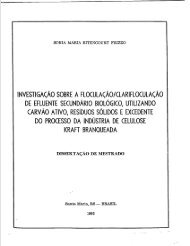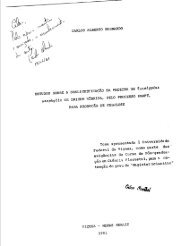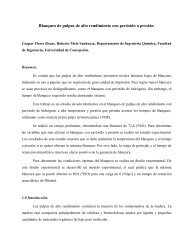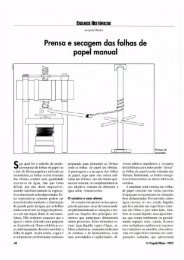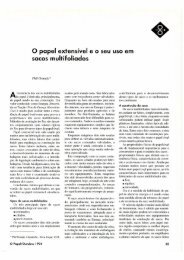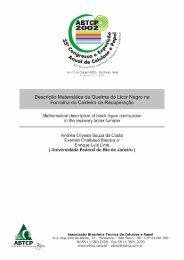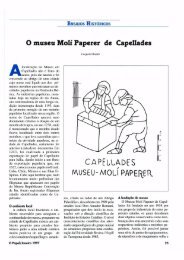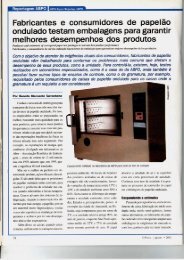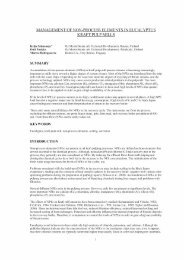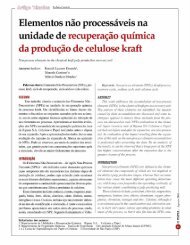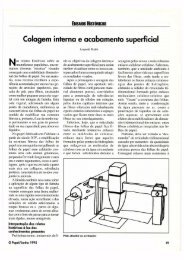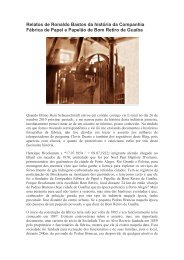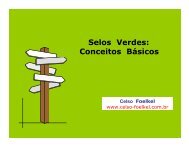O Eucalipto: um século no Brasil (The Eucalypt - Celso Foelkel
O Eucalipto: um século no Brasil (The Eucalypt - Celso Foelkel
O Eucalipto: um século no Brasil (The Eucalypt - Celso Foelkel
Create successful ePaper yourself
Turn your PDF publications into a flip-book with our unique Google optimized e-Paper software.
1 9 6 B I L H Õ E S T O N E L A D A S D E C A R B O N O N O S E U C A L I P T A I S - 1 9 6 B I L L I O N T O N S O F C A R B O N I N T H E E U C A L Y P T S P L A N T A T I O N S<br />
Quando, porém, o carbo<strong>no</strong> seqüestrado n<strong>um</strong> tronco de eucalipto é transformado em celulose,<br />
o seqüestro corresponde a <strong>um</strong> prazo bem mais longo, sete a<strong>no</strong>s de crescimento da árvore,<br />
mais alg<strong>um</strong>as semanas para que a celulose seja transformada em papel, mais <strong>um</strong> a<strong>no</strong><br />
para que o papel se degrade se for descartado na natureza, liberando <strong>no</strong>vamente o carbo<strong>no</strong>.<br />
Se o eucalipto é usado na forma de mourão, de dormente ou de poste, o seqüestro de carbo<strong>no</strong><br />
é bem mais benéfico, sete a<strong>no</strong>s para a árvore crescer e 20 ou até 25 a<strong>no</strong>s até o dormente<br />
ou poste se degradar, e parte do carbo<strong>no</strong> não volta nesse caso, é reincorporado à terra.<br />
O melhor seqüestro decorre, porém, dos usos mais <strong>no</strong>bres do eucalipto. Quando empresas<br />
como a Duratex e congêneres produzem chapas de fibras usadas como piso de<br />
residências e escritórios, pode-se prever que <strong>no</strong> total o carbo<strong>no</strong> será seqüestrado por até<br />
50 a<strong>no</strong>s. O mesmo ocorre quando o eucalipto é usado na forma de madeira, para confecção<br />
de móveis, portas, batentes e peças estruturais (madeiramentos, pontes, etc.) . Nesses<br />
casos, o seqüestro é tão duradouro que, se o plantio de florestas cultivadas com essa<br />
finalidade for muito ampliado, torna-se possível equilibrar <strong>no</strong>vamente o balanço entre<br />
liberação e captura de carbo<strong>no</strong>, evitando o aquecimento global.<br />
Para isso, é preciso que seja incentivada ao máximo a reciclagem, que leva ao aproveitamento<br />
de <strong>um</strong> mourão velho <strong>no</strong> paisagismo de chácaras, do papel usado para a produção<br />
de papel reciclado, com a vantagem adicional que nesse caso será poupada igualmente a<br />
energia para fazer a celulose e, disponível o papel reciclado, eucaliptos adultos acabarão<br />
sendo poupados. É <strong>um</strong> objetivo ainda distante, mas certamente possível.<br />
127<br />
However, when carbon sequestered in eucalypt is turned into cellulose, the sequestration<br />
corresponds to a longer period, seven years of tree growth, plus a few weeks in<br />
order for the cellulose fiber to be transformed into paper, a<strong>no</strong>ther year for the paper to<br />
degrade, if discarded into the environment, once again releasing the carbon.<br />
If the eucalypt is used as a fencepost, as a sleeper or as a post, the carbon sequestration<br />
is more beneficial: seven years for the tree to grow and 20 or even 25 years for the<br />
sleeper or post to decay, and, in this case, part of the carbon does <strong>no</strong>t return as it is<br />
reincorporated by the earth.<br />
<strong>The</strong> best sequestration results, however, from the most <strong>no</strong>ble use possible for eucalypt.<br />
When companies such as Duratex and its counterparts produce reconstituted wood<br />
panels as furniture, flooring, dividers, in homes and offices, the carbon can be expected<br />
to be fully sequestered for decades. This is also true when eucalypt is used as wood<br />
to make furniture, doors, doorposts, and structural parts (wood finishing, bridges,<br />
etc.). In these cases, the sequestration is so long-lasting that if planting forests for this<br />
purpose is increased, it will be possible to balance carbon release and capturing again,<br />
collaborating to slash global warming.<br />
In order for this to happen, recycling must be encouraged to the maxim<strong>um</strong> possible<br />
extent, leading to the use of a on old fencepost in farm landscaping, of paper to produce<br />
new, recycled paper, with the additional advantage that, in this case, the energy<br />
required to make the pulp will also be saved and if recycled paper is available, adult<br />
eucalypt trees will be spared. Although a distant objective, it is certainly possible.




